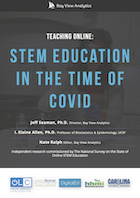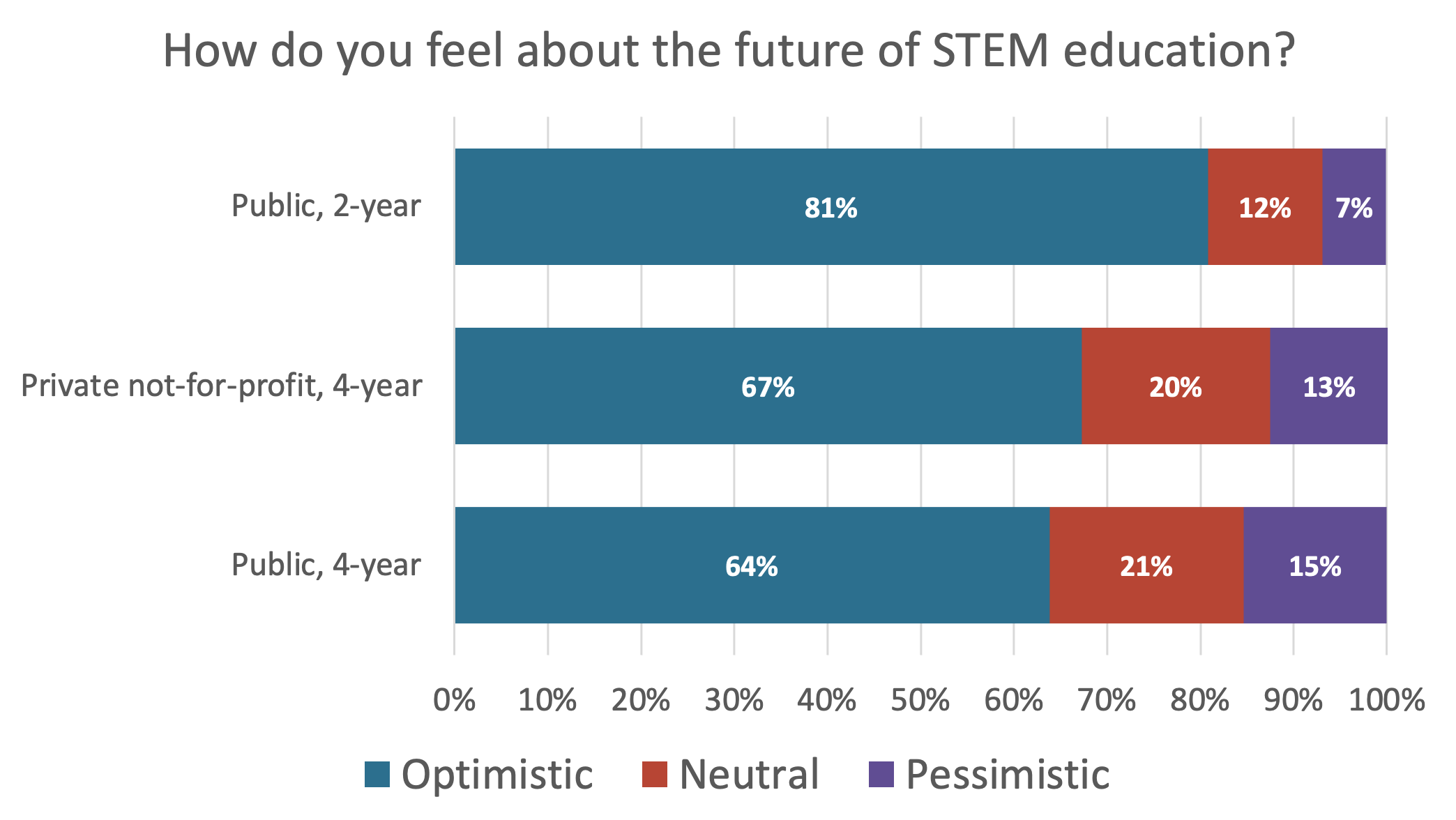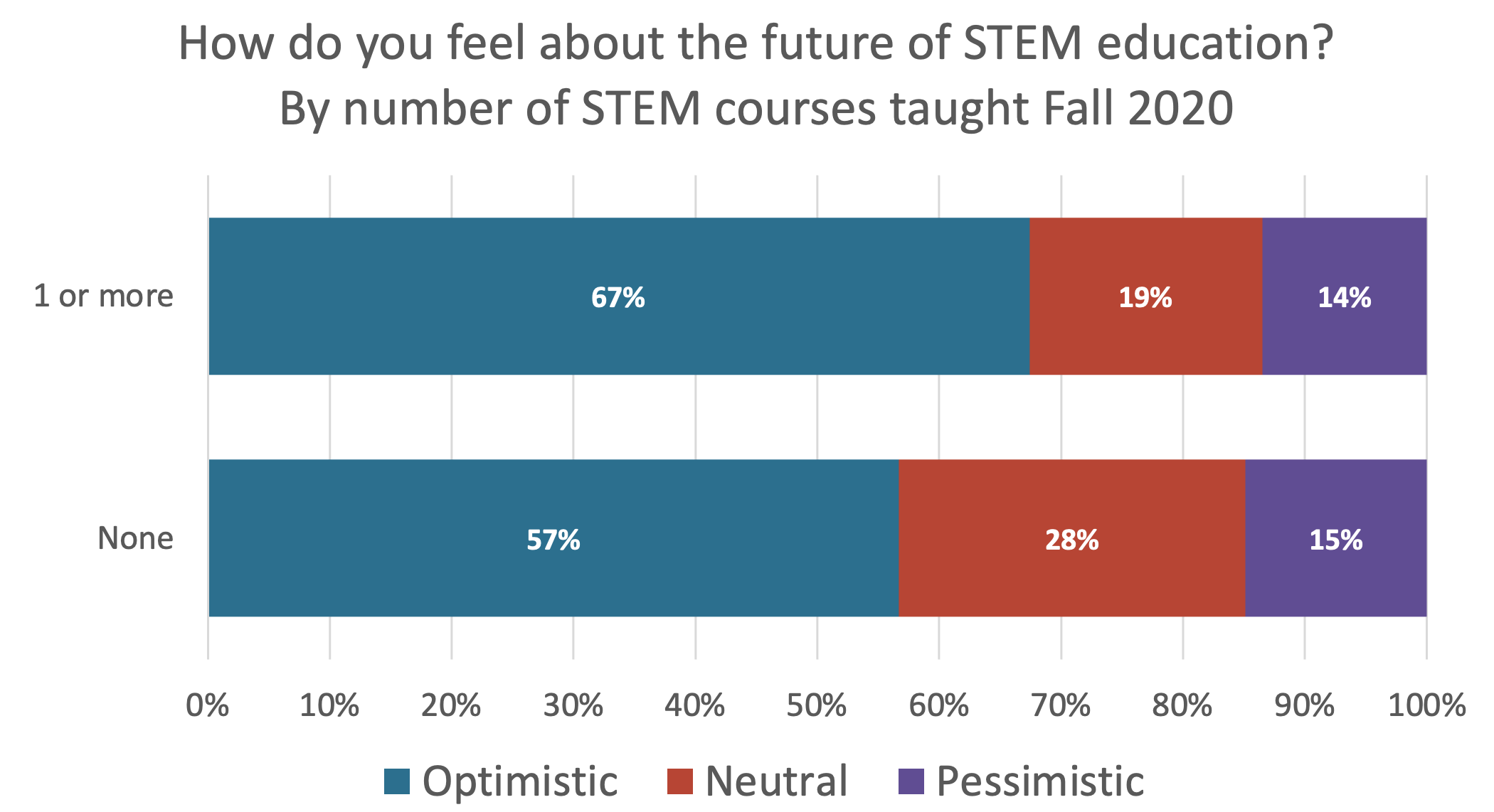Online STEM education
Teaching Online: STEM Education in the Time of COVID
The Online Learning Consortium (OLC) and Bay View Analytics, in partnership with Every Learner Everywhere, Carolina Distance Learning, DigitalEd, and with support from HHMI BioInteractive has released a new report exploring the impact of the COVID-19 pandemic on STEM faculty in higher education who underwent a hurried transition to online instruction.
Some highlights from the study include:
- 73% of respondents surveyed report having converted face-to-face coursework to remote learning, despite more than a third of respondents having no prior experience with online education.
- STEM faculty believe that almost all barriers they face in teaching their courses online are the same as those faculty in non-STEM discipline face. The need for online labs is the only barrier a majority of STEM faculty thought was unique for them.
- While generally optimistic about the potential effectiveness of online labs, only 18% of survey respondents have made use of them in their coursework.
- Respondents believe that the transition to online-learning has exacerbated the divide between the have and the have-nots, as a lack of resources (including but not limited to access to technology, robust internet connectivity, and support services) unfairly impacts underserved student populations.
Download the full report: Teaching Online: STEM Education in the Time of COVID
Research Brief
What Makes a STEM Student
Are there unique attributes to the one-third of students who are studying STEM, compared to non-STEM students? We can start to answer this question using data from the Digital Learning Pulse Survey. We investigated the demographics of current STEM students using the representative sample of 2,358 college students collected during the Fall of 2022. Indeed, we found that there are differences in the underlying attributes of STEM and non-STEM students.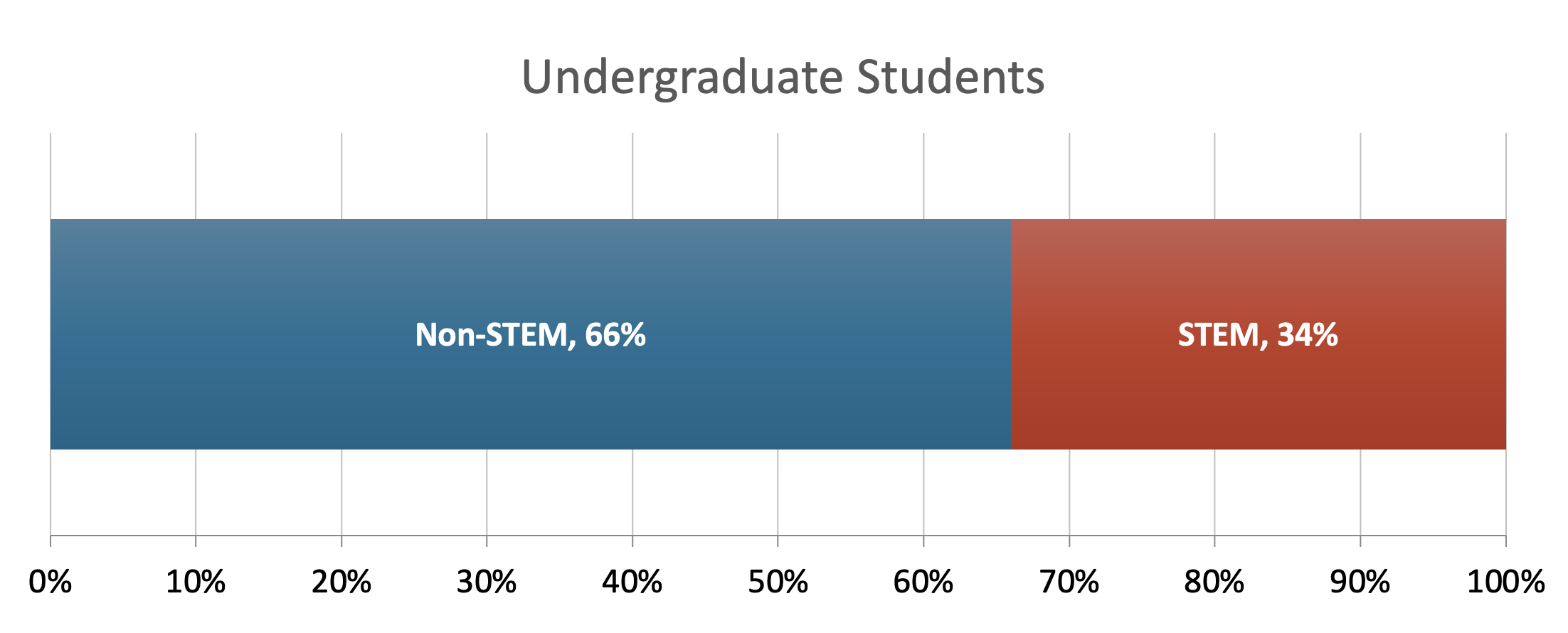
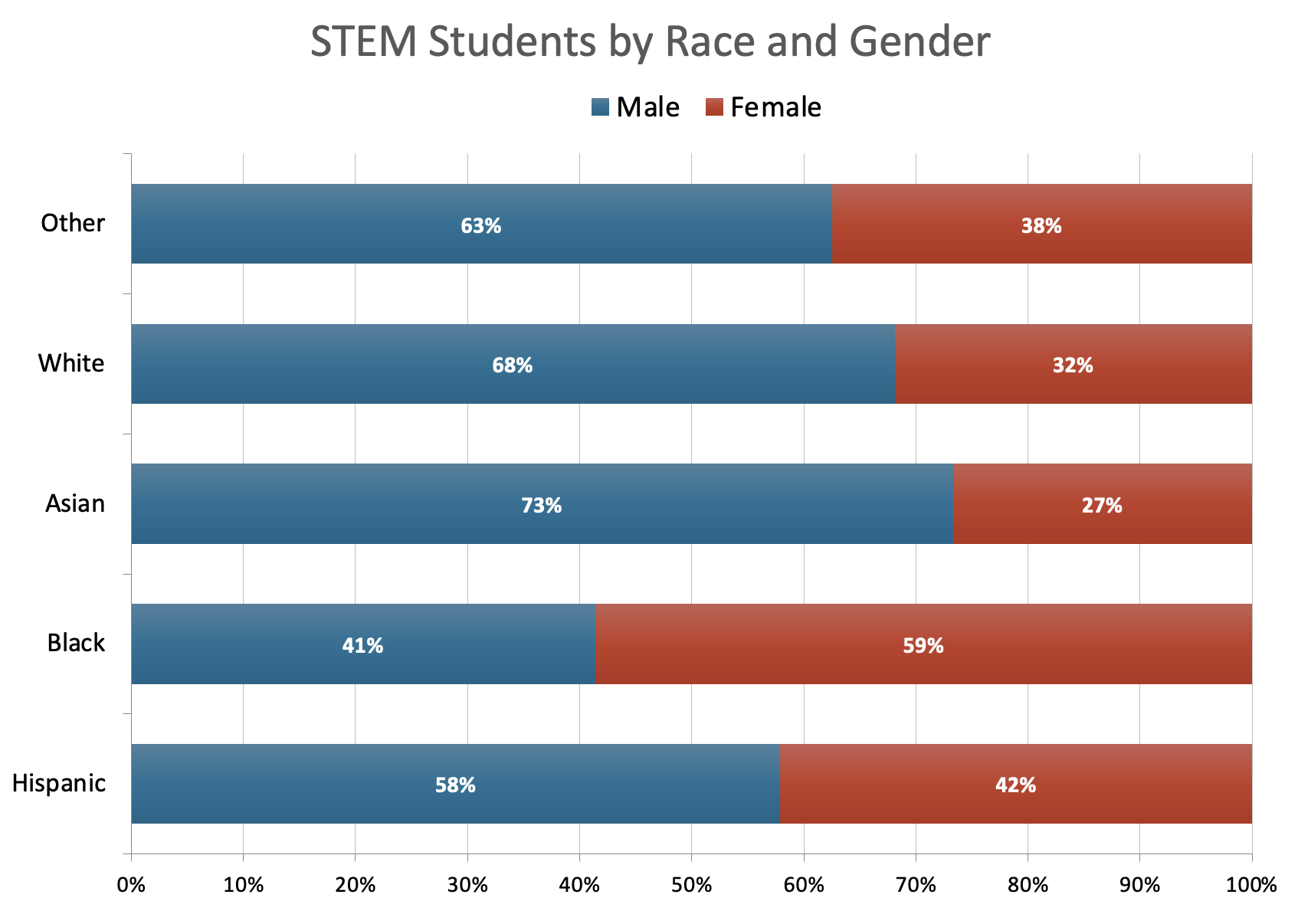
Perceptions of the Future of STEM Education
A Fall 2020 survey of STEM faculty found differing levels of optimism for the future of post-secondary STEM education. The results show that, while the majority of all respondents are optimistic, some subgroups are significantly more optimistic about the future of post-secondary STEM education overall and are also more optimistic about their personal role in higher education in the future.Overall, 66% of all respondents are optimistic about the future of STEM education at their own institution, and also optimistic about their personal role in higher education. The high level of optimism remains despite the decline in overall enrollment in colleges and universities by at least 3% from Fall 2019 to Fall 2020, according to preliminary federal data. Early data for 2021 shows an additional 3% drop (National Student Clearinghouse Research Center), with community college enrollment declining at least 15% by Fall 2020, and an additional 6% decline from Fall 2020 to Fall 2021.
Faculty at public and private 4-year institutions were less optimistic than their counterparts at public 2-year institutions. Contrasting declining enrollment rates in public 2-year colleges, 81% of faculty respondents are optimistic about the future of STEM education at their own college, and 75% are optimistic about their future in higher education. This contrasts with optimism about institutions at 4-year public and private institutions (64% and 67%, p=0.004 compared to 2-year colleges) and personal optimism (65% and 65%, p = 0.023 compared to 2-year colleges).
A few other subgroups with differences were faculty teaching labs, and between male and female faculty. Unsurprisingly, faculty teaching courses with accompanying labs are much less optimistic about the future of STEM education at their institution (62% vs 69%, p = 0.039), and about their future in higher education (61% vs 69%, p = 0.008), as the survey found the largest barrier for teaching during the COVID-19 pandemic were labs. Male faculty are more optimistic about STEM at their institution (70%) than female faculty (75%, p = 0.017), but there are no differences by gender in faculty optimism about their personal roles in higher education (67% optimistic for both genders).
Faculty at minority serving institutions did not differ in their optimism for the future from other institutions (67% and 66%) and are slightly more optimistic about their personal future in higher education (68% vs 65%, p = 0.036). No differences are seen in faculty teaching online courses based on the number of online courses taught, but a large difference is seen if no online courses are taught vs any online courses (57% vs 68%, p = 0.006).
In general, all faculty are all more optimistic than pessimistic about the future of STEM at their institution and their own future in higher education. When examined by type of institution, gender, and experience with online education, significant differences exist between groups. In addition, faculty teaching in courses with labs are more pessimistic about the future of online STEM education.
Conference Presentation
AAC&U Conference: Transforming STEM Higher EducationSession Title: STEM Education in the time of COVID - Responses from a National Survey of 869 Faculty
Presentation Time: Friday, Nov 5, 2021; 2:15pm - 3:15pm PDT
The poster presentation shares new analysis of results from our October 2020 survey of 869 U.S. STEM faculty on the impact of the pandemic. This presentation covers the barriers to successfully implementing STEM courses online and the perceived effectiveness of online labs. Additionally, the survey results show an exacerbation of equity issues during the forced move to digital remote instruction.
Download poster.
Recent Publications
Open Educational Resources
- Approaching a New Normal? Educational Resources in U.S. Higher Education, 2024
- Conflicted Digital Adoption: Educational Resources in U.S. K-12 Education, 2024
- Research Brief: Digital and OER Textbook Adoption
- Research Brief: Faculty Satisfaction with Course Materials varies by Publisher
Course Material Affordability
Digital Learning Pulse Surveys
- Infographic: 2023-2024 Digital Learning Pulse Survey
- The Digital Transformation of the Community College
- Planning for a Smaller Future: Dealing with Declining Enrollments
STEM
- Teaching Online: STEM Education in the Time of COVID
- What Makes a STEM Student
- Perceptions of the Future of STEM Education
Distance Education
- Digital Faculty: Faculty Social Media Use and Communications
- Infographic: Digital Faculty
- Grade Increase: Tracking Distance Education in the United States
Follow us on
Privacy
All survey respondents are provided complete anonymity. No personally identifiable information is released. Full privacy policy.
